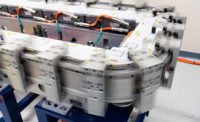Clichés have a place in manufacturing, so long as they truly fit the application. For example, the expression “It’s not rocket science” is perfectly appropriate to describe the use of a small manual press for a punching operation in the assembly of a consumer product.
However, the expression is definitely not welcome at Fenton, MO-based Beckwood Corp. when discussing the company’s Triform precision forming equipment used by aerospace customers. “It is rocket science,” says Josh Dixon, director of sales and marketing at Beckwood, which also builds custom hydraulic presses and automation systems.
In 2017, a metal-forming company that makes various components for commercial and military aircraft came to Beckwood with a challenge. The company needed a 42-inch-diameter sheet metal hydroforming press with staging table, and two 1,400-ton hydraulic presses with automated quick die-change (QDC) systems to quickly load and unload the presses. Beckwood custom designed and built the machines at its factory prior to shipment and installation at the customer’s facility.
Each press is more than 33 feet high, positioned in a 10-foot-deep pit and has a footprint of approximately 30 square feet. The QDC system has a 15,000-pound load capacity and includes a cart, a rack and a T-table staging device that allows the next die to be prepped and ready to insert upon completion of the previous run cycle.
Beckwood engineers worked closely with those on the customer’s staff to set up and implement automation. The customer was a longtime user of Siemens motion control and HMI products, and specified them for the project, including drives, PLCs, displays and motion controllers.
It also set up the system logic and data logging. The Beckwood team integrated the QDCs and overall workcell. Both Beckwood and Siemens personnel were active in commissioning the entire system.
During operation, the QDC works in tandem with the two presses and uses four 15-hp motors to drive the leadscrews on the large die-handling system. The screws are electrically geared through the onboard Siemens S7-1515 PLC to move the ram and shuttle.
Additional motors and drives on the feed tables allow the next die to be positioned during press operation. When a press cycle is completed, the air bags on the feed tables lift this die for positioning onto the QDC, then a shuttle inserts the die inside the press.
The robust PLC controller integrates function control, safety and condition display in a single module with Profinet protocol for bus communication. Through Siemens’ TIA Portal and Step 7 software, the end user can remotely customize the operation of the devices, as well as integrate multiple part files and related safety commands.
This “library” feature enables the end user to efficiently run various parts during a shift with only one software package. Safety switches can be programmed through the TIA Portal and allow operators to remain outside the work envelope when the presses are in full-machine process and monitoring mode.
All motor movements on the presses are controlled with Siemens drive technology. According to Dixon, the presses with QDC systems have reduced die setup and changeover from approximately two hours to 10 minutes.
For more information on motion control and HMI products, call Siemens at 800-743-6367 or visit https://new.siemens.com/global/en/products/automation/simatic-hmi/panels/basic-panels.html. For more information on presses, call Beckwood at 800-737-0111 or visit www.beckwoodpress.com.




